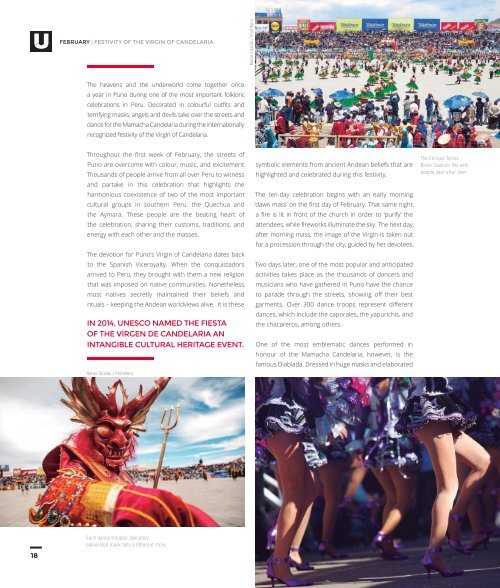UJ #17 - Traditional Peru
Create successful ePaper yourself
Turn your PDF publications into a flip-book with our unique Google optimized e-Paper software.
FEBRUARY | FESTIVITY OF THE VIRGIN OF CANDELARIA<br />
Renzo Giraldo / PromPerú<br />
The heavens and the underworld come together once<br />
a year in Puno during one of the most important folkloric<br />
celebrations in <strong>Peru</strong>. Decorated in colourful outfits and<br />
terrifying masks, angels and devils take over the streets and<br />
dance for the Mamacha Candelaria during the internationally<br />
recognized festivity of the VirgIn of Candelaria.<br />
Throughout the first week of February, the streets of<br />
Puno are overcome with colour, music, and excitement.<br />
Thousands of people arrive from all over <strong>Peru</strong> to witness<br />
and partake in this celebration that highlights the<br />
harmonious coexistence of two of the most important<br />
cultural groups in southern <strong>Peru</strong>: the Quechua and<br />
the Aymara. These people are the beating heart of<br />
the celebration, sharing their customs, traditions, and<br />
energy with each other and the masses.<br />
The devotion for Puno’s Virgin of Candelaria dates back<br />
to the Spanish Viceroyalty. When the conquistadors<br />
arrived to <strong>Peru</strong>, they brought with them a new religion<br />
that was imposed on native communities. Nonetheless,<br />
most natives secretly maintained their beliefs and<br />
rituals – keeping the Andean worldviews alive. It is these<br />
IN 2014, UNESCO NAMED THE FIESTA<br />
OF THE VIRGEN DE CANDELARIA AN<br />
INTANGIBLE CULTURAL HERITAGE EVENT.<br />
Renzo Giraldo / PromPerú<br />
symbolic elements from ancient Andean beliefs that are<br />
highlighted and celebrated during this festivity.<br />
The ten-day celebration begins with an early morning<br />
‘dawn mass’ on the first day of February. That same night,<br />
a fire is lit in front of the church in order to ‘purify’ the<br />
attendees, while fireworks illuminate the sky. The next day,<br />
after morning mass, the image of the Virgin is taken out<br />
for a procession through the city, guided by her devotees.<br />
Two days later, one of the most popular and anticipated<br />
activities takes place as the thousands of dancers and<br />
musicians who have gathered in Puno have the chance<br />
to parade through the streets, showing off their best<br />
garments. Over 300 dance troops represent different<br />
dances, which include the caporales, the yapurichis, and<br />
the chacareros, among others.<br />
One of the most emblematic dances performed in<br />
honour of the Mamacha Candelaria, however, is the<br />
famous Diablada. Dressed in huge masks and elaborated<br />
The Enrique Torres<br />
Belón Stadium fills with<br />
people year after year.<br />
18<br />
Each dance troupes’ delicately<br />
elaborated mask tells a different story.

















